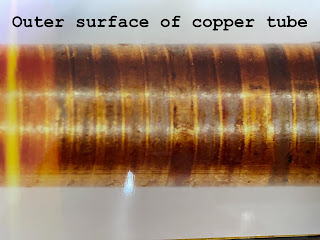จากประสบการณ์ที่ผมเคยทดสอบความต้านทานของชิ้นส่วนทองเหลืองทั้งประเภทหล่อ (Casted brass) และตีขึ้นรูป (Forged brass) จะดำเนินการตาม European Standard คือ BS EN ISO 6509 โดยมีขั้นตอนการทดสอบคร่าวๆ ดังนี้
(เคยเขียนรายงานส่งลูกค้าเป็นภาษาอังกฤษ ขี้เกียจแปล เลยขออนุญาตนำมาวางเลยละกัน ถ้าไม่เข้าใจตรงไหน ถามที่ด้านล่างเลยครับ)
1. Reagent and materials
Use only reagents of recognized analytical grade and distilled water or water of equivalent purity.
1.1 Copper (II) Chloride 1% (m/m) solution, freshly prepared.
Dissolve 12.7 g of copper (II) chloride dehydrate (CuCl2.H2O) in water and make up the volume to 1000 ml.
1.2 Phenolic resin
The other non-conducting material with similar properties, for embedding the test pieces.
1.3 Ethanol for cleaning the test pieces.
2. Test Pieces
2.1 The test pieces as shown in Fig. 1 were taken from the perpendicular and longitudinal shaping direction of casted brass and forged brass samples. They were prepared by sawing and grinding with light pressure, that the properties of the materials are unaffected.
รูปที่ 1 ตัวอย่างชิ้นส่วนทองเหลืองที่ขึ้นรูปต่างกันและใช้ในการทดสอบ
3. Preparation of test pieces
3.1 The test pieces were embedded in the phenolic resin, and the test surfaces ground using wet abrasive paper, finishing with 500 grits or finer.
3.2 The test surfaces were cleaned with ethanol prior to testing.
4. Procedures
4.1 Positioning of test pieces for test
The test pieces were placed in the beaker containing the Copper (II) chloride solution so that the test surfaces are vertical and at least 15 mm above the bottom of the beaker. The plastic foil shall then be placed over the beaker and secured.
4.2 Operating conditions
4.2.1 The beaker containing the test pieces were placed in the thermostatically controlled bath, the temperature of which were maintained at 75 +- 5 C during the entire exposure period.
4.2.2 Different alloys shall not be tested simultaneously in the same beaker.
4.3 Duration of test
The pieces were exposed continuously for 24 hours. At the end of this period, they were removed from the beaker, washed in water, in the ethanol and allowed to dry.
4.4 Preparation of section for microscopic examination
Microscopic examination of test pieces was carried out as soon as possible after exposure. If the test pieces that stored before microscopic examination, they were kept in a desiccator. Each test piece were sectioned at right angles to the exposed test surface and ground and polished for microscopic examination. The total lengths of section through the exposed surface were not less than 5 mm.
4.5 Microscopic examination
4.5.1 The micro-section prepared from each test area was examined using an optical microscope and the maximum depths of dezincification were recorded. The appropriate magnifications were used to provide the greatest accuracy of measurement.
4.5.2 The length of the section examined was the maximum possible length. If there is evidence of edge effects, for example a greater depth of dezincification along the line of the interface between the mounting material and the brass, the maximum depth of dezincification were measured at a sufficient distance from the interface to render such edge effects negligible.
สำหรับการประเมินว่าผ่านหรือไม่ผ่าน
The sample passes the test if the maximum depth of dezincification in a forging or in the transverse direction of extruded material does not exceed 100m m. A maximum depth of 200 mm is permitted in the longitudinal direction of extruded material.
รูปที่ 2 ตัวอย่างการวัดความลึกของการเกิด dezincification
รูปที่ 3 ภาพขยายแสดงการเกิด dezincification







พี่ครับ ขอรบกวนถามพี่ในด้านข้อมูลสักเล็กน้อยนะครับ คือผมกำลังหาข้อมูลเกี่ยวกับการทำElectropolishing ทองเหลือง ซึ่งจากการหาข้อมูลเเล้ว ผมพบสูตรการเตรียมผิวหน้าที่ค่อนข้างหลากหลายสูตร จึงขอความกรุณารบกวนพี่ช่วยเเนะนำสูตรการเตรียมผิวหน้าทองเหลืองทั้งการล้างคราบOxideต่างๆเเละคราบน้ำมันที่เหมาะสมกับการทดสอบBrass Electropolishing ให้หน่อยนะครับ ขอเป็นสัดส่วนการผสม เวลา ลักษณะวิธี เช่นใช้เพียงเเค่จุ่มหรือต้องขัดอ่ะครับ ช่วยส่งเข้าที่ pk_athletic@hotmail.comนะครับ ขอบคุณล่วงหน้าครับสำหรับความกรุณาอย่างสูงของพี่สยาม^^
ตอบลบผมขอด่วยครับ wasuta_se@hotmail.com
ตอบลบคือผมกำลังหาข้อมูล การขัดผิวทองเหลืองก่อนที่จะนำไปชุบโครเมี่ยมหนะครับ
โดยปกติจะขัดผิวโดยใช้กระดาษทราย แล้ว buff แล้วนำไปลงบ่อเตรียมผิว+ชุบ หนะครับ ผมลองหาข้อมูลก็เจอวิธีนี้อะครับ ไม่ทราบว่าจะสามารถลด Process ของการขัดกระดาษทรายได้บ้างหรือป่าว หรืออาจจะไม่ต้องขัดเลย ลงบ่ออย่างเดียว รบกวนหน่อยนะครับ